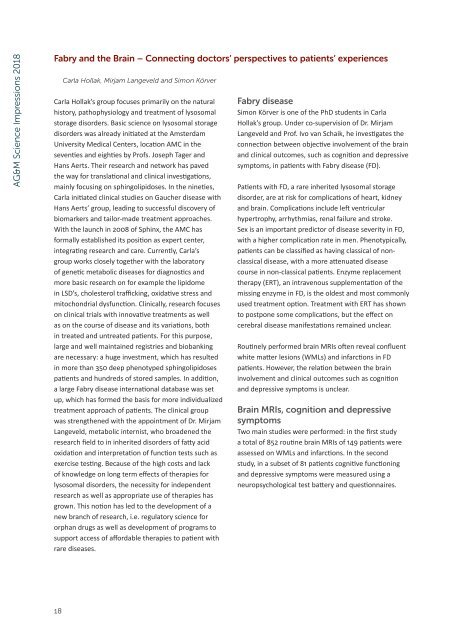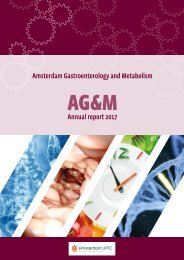AG&M annual report 2018
You also want an ePaper? Increase the reach of your titles
YUMPU automatically turns print PDFs into web optimized ePapers that Google loves.
AG&M Science Impressions <strong>2018</strong><br />
Fabry and the Brain – Connecting doctors’ perspectives to patients’ experiences<br />
Carla Hollak, Mirjam Langeveld and Simon Körver<br />
Carla Hollak’s group focuses primarily on the natural<br />
history, pathophysiology and treatment of lysosomal<br />
storage disorders. Basic science on lysosomal storage<br />
disorders was already initiated at the Amsterdam<br />
University Medical Centers, location AMC in the<br />
seventies and eighties by Profs. Joseph Tager and<br />
Hans Aerts. Their research and network has paved<br />
the way for translational and clinical investigations,<br />
mainly focusing on sphingolipidoses. In the nineties,<br />
Carla initiated clinical studies on Gaucher disease with<br />
Hans Aerts’ group, leading to successful discovery of<br />
biomarkers and tailor-made treatment approaches.<br />
With the launch in 2008 of Sphinx, the AMC has<br />
formally established its position as expert center,<br />
integrating research and care. Currently, Carla’s<br />
group works closely together with the laboratory<br />
of genetic metabolic diseases for diagnostics and<br />
more basic research on for example the lipidome<br />
in LSD’s, cholesterol trafficking, oxidative stress and<br />
mitochondrial dysfunction. Clinically, research focuses<br />
on clinical trials with innovative treatments as well<br />
as on the course of disease and its variations, both<br />
in treated and untreated patients. For this purpose,<br />
large and well maintained registries and biobanking<br />
are necessary: a huge investment, which has resulted<br />
in more than 350 deep phenotyped sphingolipidoses<br />
patients and hundreds of stored samples. In addition,<br />
a large Fabry disease international database was set<br />
up, which has formed the basis for more individualized<br />
treatment approach of patients. The clinical group<br />
was strengthened with the appointment of Dr. Mirjam<br />
Langeveld, metabolic internist, who broadened the<br />
research field to in inherited disorders of fatty acid<br />
oxidation and interpretation of function tests such as<br />
exercise testing. Because of the high costs and lack<br />
of knowledge on long term effects of therapies for<br />
lysosomal disorders, the necessity for independent<br />
research as well as appropriate use of therapies has<br />
grown. This notion has led to the development of a<br />
new branch of research, i.e. regulatory science for<br />
orphan drugs as well as development of programs to<br />
support access of affordable therapies to patient with<br />
rare diseases.<br />
Fabry disease<br />
Simon Körver is one of the PhD students in Carla<br />
Hollak’s group. Under co-supervision of Dr. Mirjam<br />
Langeveld and Prof. Ivo van Schaik, he investigates the<br />
connection between objective involvement of the brain<br />
and clinical outcomes, such as cognition and depressive<br />
symptoms, in patients with Fabry disease (FD).<br />
Patients with FD, a rare inherited lysosomal storage<br />
disorder, are at risk for complications of heart, kidney<br />
and brain. Complications include left ventricular<br />
hypertrophy, arrhythmias, renal failure and stroke.<br />
Sex is an important predictor of disease severity in FD,<br />
with a higher complication rate in men. Phenotypically,<br />
patients can be classified as having classical of nonclassical<br />
disease, with a more attenuated disease<br />
course in non-classical patients. Enzyme replacement<br />
therapy (ERT), an intravenous supplementation of the<br />
missing enzyme in FD, is the oldest and most commonly<br />
used treatment option. Treatment with ERT has shown<br />
to postpone some complications, but the effect on<br />
cerebral disease manifestations remained unclear.<br />
Routinely performed brain MRIs often reveal confluent<br />
white matter lesions (WMLs) and infarctions in FD<br />
patients. However, the relation between the brain<br />
involvement and clinical outcomes such as cognition<br />
and depressive symptoms is unclear.<br />
Brain MRIs, cognition and depressive<br />
symptoms<br />
Two main studies were performed: in the first study<br />
a total of 852 routine brain MRIs of 149 patients were<br />
assessed on WMLs and infarctions. In the second<br />
study, in a subset of 81 patients cognitive functioning<br />
and depressive symptoms were measured using a<br />
neuropsychological test battery and questionnaires.<br />
18



